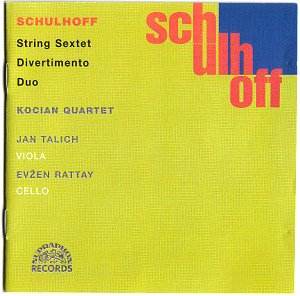The so-called ‘Terezin’ composers, those Jewish
Czechs temporarily imprisoned by the Nazis in that cultural ghetto
in the 1940s have, since the fall of Communism in 1989, established
themselves as twentieth century artists to be reckoned with, despite
their tragically short artistic careers. Increasingly we are becoming
familiar with the names of Victor Ullman, Hans Krasa, Pavel Haas
and Gideon Klein.
Another Czech composer, whose output seems consistently
high in quality, is Ervin Schulhoff. Born in Prague in 1894, he
studied in Vienna, Leipzig and Cologne. In Leipzig he was taught
by Max Reger, who guided him towards a neo-classical style. Schulhoff
was friendly with the great pianist Artur Schnabel and is reputed
to have had lessons from Claude Debussy. Schulhoff quickly gained
a reputation as a formidable pianist but composition was his main
objective, acknowledging Strauss, Debussy and Scriabin as significant
early influences
In Germany in the 1920s and 1930s Schulhoff allied
himself to the left-wing avant-garde with its Dadaist art movement.
He often changed his musical styles and flirted very successfully
with jazz – considered "degenerate music" by the Nazis.
In 1939 he was arrested and imprisoned, firstly in Prague then
in the Wulzburg concentration camp in Bavaria where he died, seemingly
from tuberculosis, in August 1942.
This Supraphon release of Schulhoff Chamber
Works Volume 2 contains three fascinating early works. The
immediately gratifying five movement Divertimento for String
Quartet op.14 was written in Cologne in the spring of 1914
and with its clean and lyrical lines could have come from the
pen of Gustav Holst. The work is charming but contains an underlying
sense of melancholy, a feeling that we consider is exclusive to
English string music. The maturity and perception of the twenty
year-old Schulhoff delights at every turn aided by the accuracy
and passionate intensity of the Kocian Quartet. From the jaunty
almost spiky rhythms of the opening movement Lebhaft the
listener’s attention is caught. The final Rondo contains
elements of ‘the hunt’, that popular 18th century subject for
artists. Schulhoff fashions it as a tribute to Haydn, as successfully
as Prokofiev did three years later in his ‘Classical’ Symphony.
Make no mistake, the work is up there, a worthy companion to the
Prokofiev; an example of timeless neo-classical writing.
The marvellous yet challenging four movement
String Sextet for two violins, two violas and two cellos
written between 1920-24 provides a stark contrast. In the Great
War Schulhoff had fought in the ranks of the Austrian army on
the Eastern Front. The experience provoked a major change in style.
From the expressionist first movement onwards the music is muscular
and resolute but never predictable. With two slow movements (the
second is the rather nihilistic Finale) a post-war cynicism
informs the work. The highlight of the score is the expressive
and often dreamy second movement Andante which alters in
mood between points 3:03-4:01. It is evocative of a Vaughan Williams
string orchestra piece and the ghostly episodes with chilling
tremolo accompaniment towards the conclusion are memorable.
This contrasts with the irony of the short third movement Burlesca
that follows, based on a Slav folk melody. The expanded Kocian
Quartet show their ardent belief in this music and display great
commitment in an accomplished performance.
Influential composer Paul Hindemith was one of
the sextet members in this work’s 1924 premiere performance. No
doubt he relished the style which could be billed as ‘Schoenberg
meets Bartók’. Published posthumously in 1978, only a few
playings of the score are enough to convince that this is a substantial
addition to 20th century chamber music.
The remaining composition on this rewarding Schulhoff
CD is the excellent Duo for Violin and Cello. Dating from
1925, the Duo is dedicated to Janáček,
whom Schulhoff knew. Notably Kodaly, Gliere, Martinů and
in particular Ravel have written for this rare instrumental combination.
Now we discover another Duo, which I can confidently describe
as a seventeen-minute gem. Violinist Pavel Hula and cellist
Vaclav Bernasek breathe animated life into Schulhoff’s creation.
The second movement Zingaresca that follows the rhythmical
opening movement has the swagger of Stravinsky’s ‘The Soldier’s
Tale’. In the third movement Andantino a rhapsodic flow
is cleverly shared between the two players. The inventive and
expressive final movement Moderato alternates meaty Schoenberg-like
modulations with a lyrical meandering and concludes with a witty,
scampering ending; all in under four minutes.
At his untimely death Schulhoff was working on
his Eighth Symphony. He was only forty-six years old. Although
a tragic loss to the post-war musical world it is gratifying that
Schulhoff’s ‘art’ is finally achieving the recognition that it
so richly deserves. The Supraphon label have to be congratulated
for championing Schulhoff. Since the mid-1990s the label has released
thirteen CDs of his output; comprising symphonies, concertos,
songs and much chamber music. Furthermore, labels such as Deutsche
Grammophon, BIS and Koch Schwann have all dipped their toes into
the Schulhoff water.
Repeated listening to these Schulhoff scores
offers revelatory rewards. In fact I strongly and confidently
feel that we have discovered a major twentieth century composer
here. This Supraphon release of Schulhoff chamber works superbly
performed and recorded cannot be recommended highly enough. It
demands to be heard.
Michael Cookson
